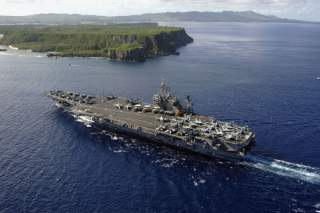Keeping America's Pacific Bases Competitive
How the Navy can maintain its edge in Asia without risking needless escalation toward war.
Finally, the Navy can consider utilizing two (or more) carrier battle groups to conduct military operations in the South and East China Seas. Aircraft carriers allow multiple mobile basing without diminishing firepower or operational tempo, all while obviating the need for constant, complex coordination between multiple land-based operators. To be sure, use of the carrier battle group itself is not without significant risks, which include China’s development of effective anti-ship ballistic missile technology, but a maneuvering carrier battle group utilizing deft and imaginative counter-reconnaissance and -surveillance tactics while conducting episodic raids against enemy targets would present a significant challenge to PRC military operations, all while minimizing the risks of warfare escalation.
In any case, there are no easy solutions. Options like these complicate force generation, slow sortie rates and generally impinge on the U.S. ability to achieve a consistent and sustained high operational tempo. Taken independently, none of these approaches is likely to be entirely successful. However, taken together, they do allow the United States to maintain a high operational tempo in combat while also reducing the risks that a local war could escalate into a regional or even global conflict. These tradeoffs demand serious examination by U.S. military leadership, especially if escalation is to be avoided.
Michael Petersen is an Associate Professor in the Strategic and Operational Research Department at the U.S. Naval War College. He holds a doctorate in History from the University of Maryland, College Park. The opinions expressed here are his own and do not reflect those of the Naval War College, the U.S. Navy, or the part of the Department of Defense.
Image: Wikimedia Commons/U.S. Navy

